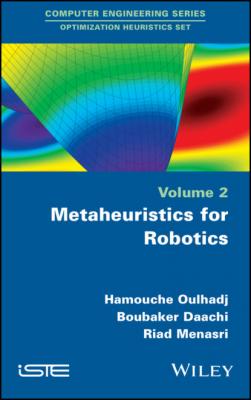Metaheuristics for Robotics. Hamouche Oulhadj
Читать онлайн.| Название | Metaheuristics for Robotics |
|---|---|
| Автор произведения | Hamouche Oulhadj |
| Жанр | Программы |
| Серия | |
| Издательство | Программы |
| Год выпуска | 0 |
| isbn | 9781119706991 |
Table of Contents
1 Cover
2 Preface
4 1 Optimization: Theoretical Foundations and Methods 1.1. The formalization of an optimization problem 1.2. Constrained optimization methods 1.3. Classification of optimization methods 1.4. Conclusion 1.5. Bibliography
5 2 Metaheuristics for Robotics 2.1. Introduction 2.2. Metaheuristics for trajectory planning problems 2.3. Metaheuristics for automatic control problems 2.4. Conclusion 2.5. Bibliography
6 3 Metaheuristics for Constrained and Unconstrained Trajectory Planning 3.1. Introduction 3.2. Obstacle avoidance 3.3. Bilevel optimization problem 3.4. Formulation of the trajectory planning problem 3.5. Resolution with a bigenetic algorithm 3.6. Simulation with the model of the Neuromate robot 3.7. Conclusion 3.8. Bibliography
7 4 Metaheuristics for Trajectory Generation by Polynomial Interpolation 4.1. Introduction 4.2. Description of the problem addressed 4.3. Formalization 4.4. Resolution 4.5. Simulation results 4.6. Conclusion 4.7. Bibliography
8 5 Particle Swarm Optimization for Exoskeleton Control 5.1. Introduction 5.2. The system and the problem under consideration 5.3. Proposed control algorithm 5.4. Experimental results 5.5. Conclusion 5.6. Bibliography
10 Index
List of Tables
1 Chapter 2Table 2.1. Effects of the actions of the PID regulator
2 Chapter 3Table 3.1. Limits of the robot jointsTable 3.2. Geometric parametersTable 3.3. Position of obstacles in the robot workspaceTable 3.4. Algorithm parameters
3 Chapter 4Table 4.1. Algorithm parametersTable 4.2. Maximum values for the variables of the objective functionTable 4.3. Values of weighting parameters under testTable 4.4. Characteristics of some interpolation methods
4 Chapter 5Table 5.1. Characteristics of the participantsTable 5.2. Controller parameter values
List of Illustrations
1 Chapter 1Figure 1.1. Domain of admissible solutions and forbidden domainFigure 1.2. 1D multimodal objective function, in the absence of noiseFigure 1.3. 1D multimodal objective function, in the presence of noiseFigure 1.4. 2D multimodal objective function, in the absence of noiseFigure 1.5. 2D multimodal objective function, in the presence of noiseFigure 1.6. Constrained optimization. ■ Local minima. • Global minimum. For a co...Figure 1.7. Constrained optimization. ■ Global minimum in the presence of constr...Figure 1.8. Refinement of the performance of an algorithmFigure 1.9. Some deterministic methodsFigure 1.10. Some stochastic methods
2 Chapter 2Figure 2.1. Different stages of trajectory planningFigure 2.2. Hybrid planning: joint space -> Cartesian spaceFigure 2.3. An example of a hybrid planning strategyFigure 2.4. Hybrid planning: Cartesian space -> joint spaceFigure 2.5. Principle of a particle swarm algorithmFigure 2.6. Principle of an evolutionary algorithmFigure 2.7. Trajectory outlineFigure 2.8. Typical system response
3 Chapter 3Figure 3.1. Obstacle modeling. For a color version of this figure, see www.iste....Figure 3.2. Plane used to measure distances. For a color version of this figure,...Figure 3.3. Planar robot with an obstacleFigure 3.4. Illustrated example of obstacle detectionFigure 3.5. Description of the bigenetic algorithmFigure 3.6. Neuromate robot. The Neuromate robot has five degrees of freedom. Al...Figure 3.7. Geometric configuration of the robot. For a color version of this fi...Figure 3.8. Chromosomes of the algorithmFigure 3.9. Evolution of the best individual in the first levelFigure 3.10. Evolution of the best individual at the second levelFigure 3.11. End-effector position errorFigure 3.12. CPU timeFigure 3.13. Successive robot configurations. For a color version of this figure...Figure 3.14. Two solutions found by the algorithm. For a color version of this f...Figure 3.15. Variation in joint variables. For a color version of this figure, s...Figure 3.16. Best individual evolution. For a color version of this figure, see ...
4 Chapter 4Figure 4.1. Example of a polynomial curveFigure 4.2. Algorithm overall outlineFigure 4.3. Solution codingFigure 4.4. Angular positionFigure 4.5. Angular velocityFigure 4.6. Angular accelerationFigure 4.7. Mean and standard deviation of the objective functionFigure 4.8. Maximum velocitiesFigure 4.9. Maximum and minimum accelerationsFigure 4.10. Maximum jerkFigure 4.11. Maximum motion timeFigure 4.12. CPU timeFigure 4.13. Mean and standard deviation of the objective function after converg...Figure 4.14. Maximum velocityFigure 4.15. Maximum accelerationFigure 4.16. Maximum jerkFigure 4.17. Maximum timeFigure 4.18. Angular position with cubic splinesFigure 4.19. Angular velocity with cubic splinesFigure 4.20. Angular acceleration with cubic splinesFigure 4.21. Angular position
